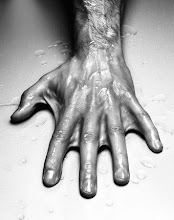I have just updated the previous parts with some photos:
Part 1 - making it
Part 2 - dressing it
This part - cooking it
Cooking is a great way to ruin an otherwise tip-top pâte à choux so here are some tips I've learnt over the last few weeks.
Finding the right temperature for your oven is very important. The pastry needs to be dried out as much as cooked. If the oven is too hot, the pastry will burn on the outside while still moist within. If the oven is too cold, the pastry will not rise as intended. 220°C should be about right.
Another important factor to control is humidity in the oven. Any sudden changes will cause a sudden drop in humidity, the pastry to collapse and zeugma. This is why you should not open the oven door while you have choux pastry on the hot; at least, not until it has started to colour (at which point the crust will hold the structure).
Different chefs recommend different strategies for regulating the humidity.
- You can leave the oven door shut throughout
- You can prop the door ever so slightly ajar (e.g. with the handle of a wooden spoon) to regulate the release of vapour throughout cooking
- You can start with the door shut so the humid atmosphere helps the pastry rise and then, once at colouration, insert said spoon to lower the humidity and help the pastry dry through
Part 1 - making it
Part 2 - dressing it
This part - cooking it
Cooking is a great way to ruin an otherwise tip-top pâte à choux so here are some tips I've learnt over the last few weeks.
Finding the right temperature for your oven is very important. The pastry needs to be dried out as much as cooked. If the oven is too hot, the pastry will burn on the outside while still moist within. If the oven is too cold, the pastry will not rise as intended. 220°C should be about right.
Another important factor to control is humidity in the oven. Any sudden changes will cause a sudden drop in humidity, the pastry to collapse and zeugma. This is why you should not open the oven door while you have choux pastry on the hot; at least, not until it has started to colour (at which point the crust will hold the structure).
Different chefs recommend different strategies for regulating the humidity.
- You can leave the oven door shut throughout
- You can prop the door ever so slightly ajar (e.g. with the handle of a wooden spoon) to regulate the release of vapour throughout cooking
- You can start with the door shut so the humid atmosphere helps the pastry rise and then, once at colouration, insert said spoon to lower the humidity and help the pastry dry through
I've tried all these methods and they all seem to achieve the desired result.
For bigger pieces like the outer ring of a Paris-Brest, it can be hard to dry through. One technique is to lower the oven temperature once you are nearly at the desired colouration. Another is to cut the thing open at the end of cooking and replace it in the oven at a lower temp (or just while the oven cools). This really helps let all the steam within out.
It is very easy to undercook choux pastry. If it is undercooked it will still be soft, or it will soften a few moments after being removed from the oven. Given that many choux pieces are filled with cream, you're giving sogginess a head start if your pastry is at all moist. It will, of course, soften up again once loaded. To test if the pastry is cooked, just give your buns a good squeeze. There should be no give.
If cooking chouquettes it is a good tip to double your oven tray so that the sugar grains in contact with the tray do not caramelize too much.

The photo above shows a variety of bits fresh from the oven. You can see how much they've swollen by looking at the dressed pastry here. Not my best. The eclairs are a little wonky, the salambôs a trifle bulky and the bodies of the religieuses are a tad large. Still, it's nice to know my nuns are only human.

No comments:
Post a Comment